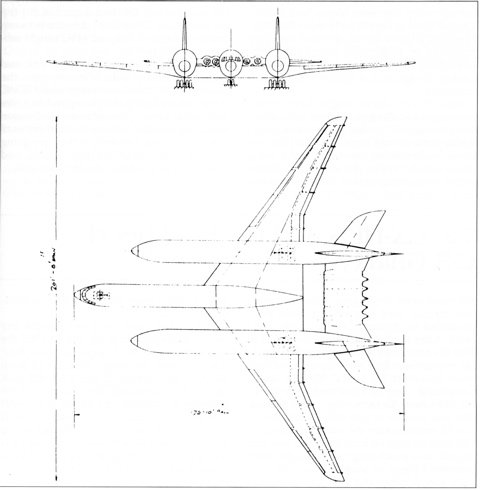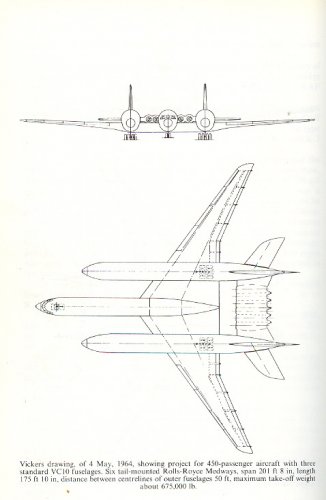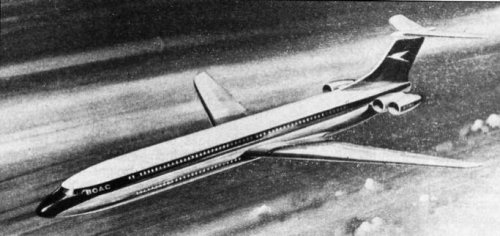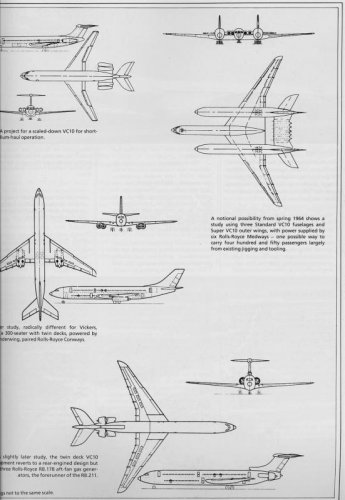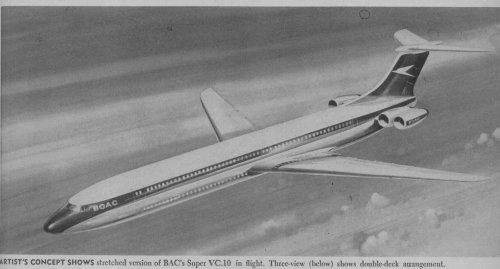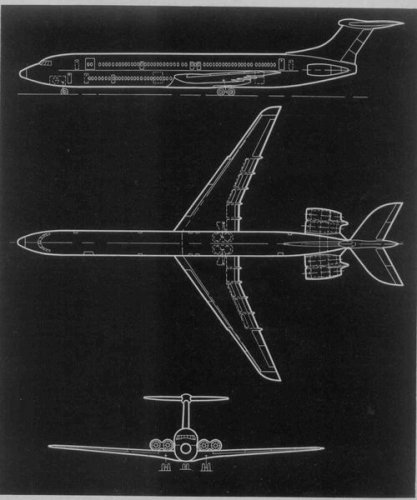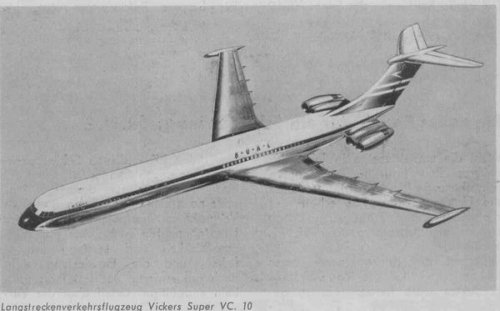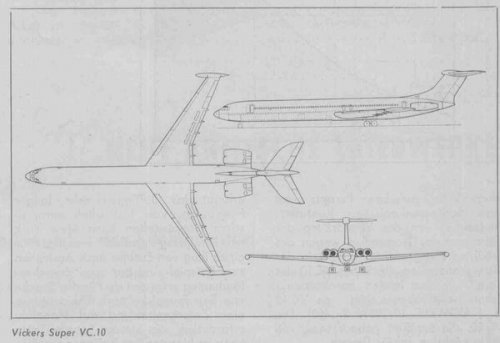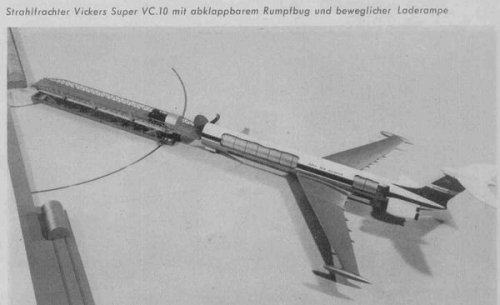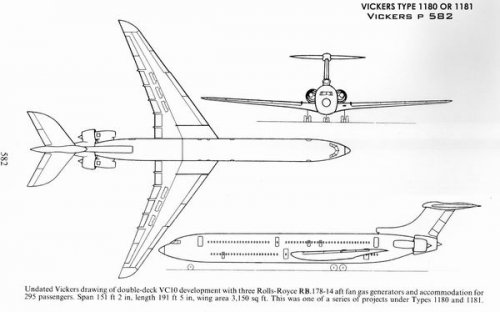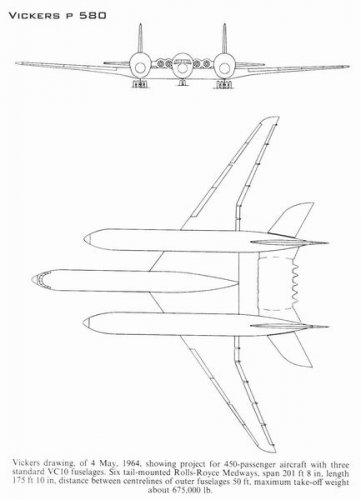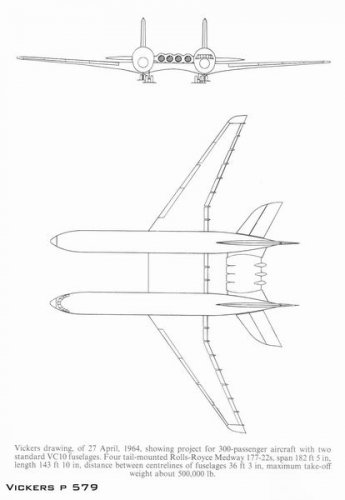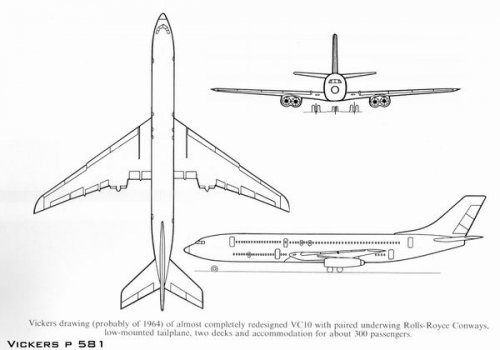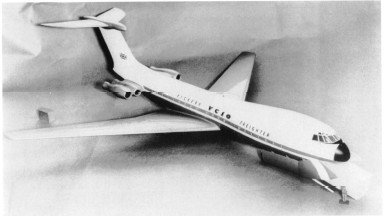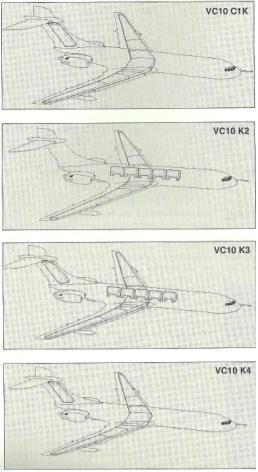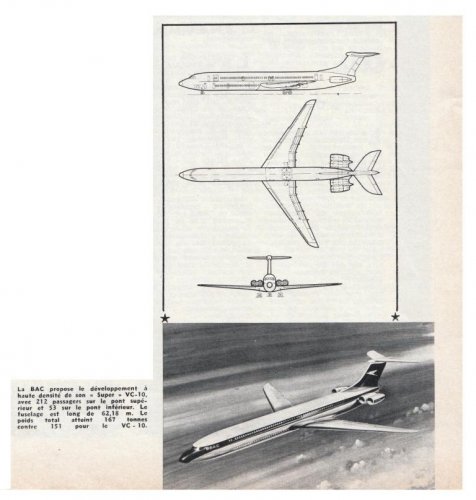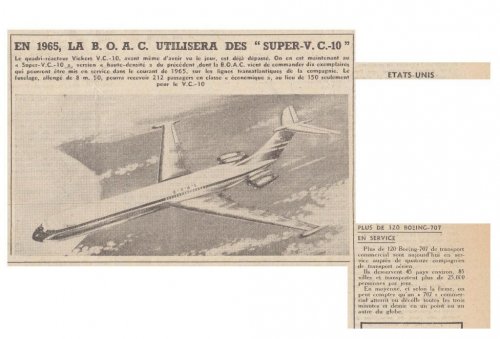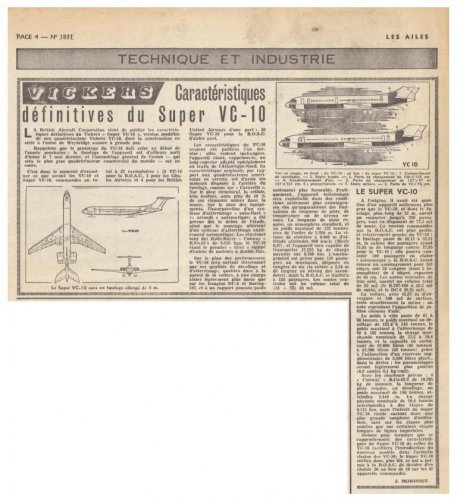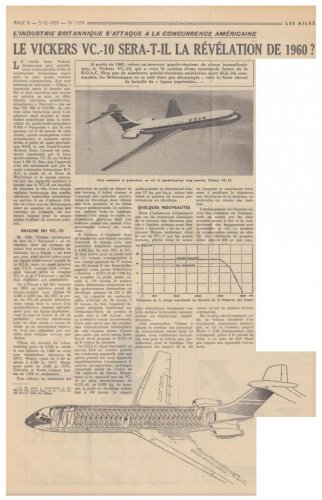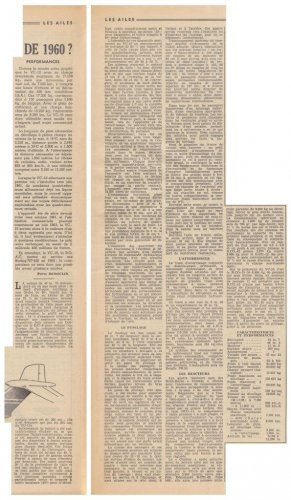You are using an out of date browser. It may not display this or other websites correctly.
You should upgrade or use an alternative browser.
You should upgrade or use an alternative browser.
Vickers VC-10 Projects
- Thread starter Antonio
- Start date
- Joined
- 27 December 2005
- Messages
- 16,722
- Reaction score
- 20,509
Double-deck Vickers VC-10.
http://rides.webshots.com/photo/1390155408048918155FhpzkHIn a quest for a larger-capacity of its Super VC-10, Vickers entertained the idea of a doubledeck version of its elegant four-engined airliner. Compare this design with that of the "extended" Boeing 707. (Source: Unknown, possibly The Putnam Aviation Review, of which only one issue was published, in the 1980s)
Attachments
Vickers VC-10 design concepts studied in 1964.
http://rides.webshots.com/photo/1129349558048918155mnKYmEForeseeing a need for a larger-capacity transcontinental airliner, Vickers proposed several unusual designs in 1964. Source: The Putnam Aviation Review, Vol. 1, No. 1, May 1989, page 31.
Attachments
- Joined
- 11 March 2006
- Messages
- 8,640
- Reaction score
- 3,286
foiling
ACCESS: Secret
- Joined
- 12 August 2007
- Messages
- 365
- Reaction score
- 126
foiling
ACCESS: Secret
- Joined
- 12 August 2007
- Messages
- 365
- Reaction score
- 126
Bailey
ACCESS: Secret
- Joined
- 24 July 2009
- Messages
- 308
- Reaction score
- 35
Hi Maveric,
The numbers above are Vickers-Supermarine type numbers, which match with the strike aircraft projects. The "P" numbers shown on the scans, must be an entirely different system.
Regards Bailey.
´m a little confused, I know the Vickers-Numbers 579, 580, 581 and 582 as strike aircraft projects...
The numbers above are Vickers-Supermarine type numbers, which match with the strike aircraft projects. The "P" numbers shown on the scans, must be an entirely different system.
Regards Bailey.
foiling
ACCESS: Secret
- Joined
- 12 August 2007
- Messages
- 365
- Reaction score
- 126
Bailey, if it is the 'p' numbers on my 3-views that you are wondering about please let me put your mind at rest: those scans were on my computer, and the p 582 etc is simply the page number in the book "Vickers Aircraft since 1908". I was never expecting anyone to be interested in the 3-views I'd collected, so it never occurred to me that it would be associated with the aircraft model, although that is an understandable conclusion. You guys are sooooo sharp, and see things I don't anticipate. There is a type number with the first scan, however.
- Joined
- 20 January 2007
- Messages
- 906
- Reaction score
- 971
SLL: at what point does a VC-10 stop being a VC-10: I surmise: The financial terms of the merger, trading from 1/7/60, creating BAC left legacy pain with the sire. So Vickers', not BAC's, Board carried the compounding losses of Vanguard and VC10. So, I guess, as long as some pedigree could be traced between the 1957 concept and 1960s' notions, Vickers would carry the adaptation engineering cost and would capture any profit. I think BAC adopted the 1966 dubble-bubble pitches to BOAC v.747-100.
Hi,alertken said:SLL: at what point does a VC-10 stop being a VC-10: I surmise: The financial terms of the merger, trading from 1/7/60, creating BAC left legacy pain with the sire. So Vickers', not BAC's, Board carried the compounding losses of Vanguard and VC10. So, I guess, as long as some pedigree could be traced between the 1957 concept and 1960s' notions, Vickers would carry the adaptation engineering cost and would capture any profit. I think BAC adopted the 1966 dubble-bubble pitches to BOAC v.747-100.
Possibly more in common than those aircraft collected under the 707 umbrella?
The Rolls-Royce RB 178-14 aft-fan gas generators/ turbofans expected to give what sort of performance?
I bet the VC7 that had an even bigger wing could have produced some very interesting cost effective developments with out the political cancer of forced amalgamation.
Happy New Year when it comes!
- Joined
- 22 April 2012
- Messages
- 2,286
- Reaction score
- 1,961
Scanning Flight Global's archives I have found yet another variant, this is a 'Developed Super VC-10'. The key points are that is was intended to have an additional 10ft fuselage stretch over the originally proposed 212 seat VC-10 taking total length to 196ft 6inches (extra length was to be inserted ahead of the wing) allowing for a total passenger capacity of 222. it was to be powered by Rolls Royce Conway 42/7 engnes of 24,000lb thrust each.
Source: http://www.flightglobal.com/pdfarchive/view/1960/1960%20-%202723.html
Source: http://www.flightglobal.com/pdfarchive/view/1960/1960%20-%202723.html
foiling said:Oops! I had four Vickers 3-views to send, thinking they'd go together. Realised my mistake, so here are the other 3. ;D
Interesting that the first picture (P 581) shows the engines directly on the wings - it seems pylons were still not favoured.
- Joined
- 30 November 2007
- Messages
- 1,090
- Reaction score
- 452
Yes PMN1, and thank you for bringing this back to the original subject! I understand the optimal design configuration is to have the engines mounted at the centre of gravity. Looking that the rear engined configurations studied, it is possible that the Superb might have suffered for the same controllability problems that plagued the Tupolev Tu-154 and Ilyushin IL-62 (and which also must have frightened Hawker-Siddeley's designers working on the HS132). I suppose the lesson is you can't put that much weight at the back of such a large airframe......
Terry (Caravellarella)
Terry (Caravellarella)
- Joined
- 27 December 2005
- Messages
- 16,722
- Reaction score
- 20,509
Topic renamed and split.
- Joined
- 30 November 2007
- Messages
- 1,090
- Reaction score
- 452
More fabe and thank you Overscan......
I have often wondered about the safety/evacuation aspects of all the VC10 double-deck designs. In the event of ditching wouldn't the lower deck occupants be below the water level? In the event of a wheels-up landing, wouldn't the the lower deck occupants be particularly vulnerable. Does anyone know if BAC considered these issues?
Lockheed added an underfuselage skid to the TriStar fitted with lower deck lounges that could be occupied during take-off and landing......
Terry (Caravellarella)
I have often wondered about the safety/evacuation aspects of all the VC10 double-deck designs. In the event of ditching wouldn't the lower deck occupants be below the water level? In the event of a wheels-up landing, wouldn't the the lower deck occupants be particularly vulnerable. Does anyone know if BAC considered these issues?
Lockheed added an underfuselage skid to the TriStar fitted with lower deck lounges that could be occupied during take-off and landing......
Terry (Caravellarella)
- Joined
- 20 January 2007
- Messages
- 906
- Reaction score
- 971
Even with the structural strengthening, the PSA L.1011-1 with lower lounge were, I believe, not operated with those seats sold. IIRC, on aborted take-off the nose wheel was designed to collapse into that area. 747 same, so only cargo underfloor in the lower 41.
The overriding issue with all VC10 schemes was weight. Hand-built, brick dunny: weight would be “30% less if designed (now…builders) appear to have adhered only loosely to the drawings (New) parts must be machined to match the unserviceable part” O/C,VC10 Major Servicing,St.Athan, P63,3/99,Overhaul & Maintenance magazine. Not solely a Vickers phenomenon: DC-8 structure was far less interchangeable than 707.
The overriding issue with all VC10 schemes was weight. Hand-built, brick dunny: weight would be “30% less if designed (now…builders) appear to have adhered only loosely to the drawings (New) parts must be machined to match the unserviceable part” O/C,VC10 Major Servicing,St.Athan, P63,3/99,Overhaul & Maintenance magazine. Not solely a Vickers phenomenon: DC-8 structure was far less interchangeable than 707.
- Joined
- 30 November 2007
- Messages
- 1,090
- Reaction score
- 452
Dear Alertken, again I love your analysis......
Are we eroding the unmerited mystique that has grown up around the VC-10 (hope so ;D)......
Terry (Caravellarella)
Are we eroding the unmerited mystique that has grown up around the VC-10 (hope so ;D)......
Terry (Caravellarella)
- Joined
- 22 April 2012
- Messages
- 2,286
- Reaction score
- 1,961
alertken said:Even with the structural strengthening, the PSA L.1011-1 with lower lounge were, I believe, not operated with those seats sold. IIRC, on aborted take-off the nose wheel was designed to collapse into that area. 747 same, so only cargo underfloor in the lower 41.
The overriding issue with all VC10 schemes was weight. Hand-built, brick dunny: weight would be “30% less if designed (now…builders) appear to have adhered only loosely to the drawings (New) parts must be machined to match the unserviceable part” O/C,VC10 Major Servicing,St.Athan, P63,3/99,Overhaul & Maintenance magazine. Not solely a Vickers phenomenon: DC-8 structure was far less interchangeable than 707.
Interestingly the Nimrod airframe exhibited similar characteristics when it came to making them into MRA4's and I have seen a story about USAF personnel being astonished to discover the primitive manner in which the Handley Page Victor was manufactured. This also fits with the various stories of companies reusing jigs and tooling from earlier projects (I believe this happened in the case of both the VC-7 and VC-10). It seem to have been something of a British trait in this time frame and speaks to the poverty of the industry that helped to bring it down.
foiling said:Oops! I had four Vickers 3-views to send, thinking they'd go together. Realised my mistake, so here are the other 3. ;D
It has just occurred to me that the engine configuration in the top picture shows considerable resemblance to that of the DeHavilland DH.118, 119 and 120. Apparently Vickers looked at an underwing configuration in the dying days of the VC.7 programme, but the resemblence to the DeHavilland designs is remarkable.
I suspect this design to be one of the later ones with a new wing and lower deck seating expanded to six abreast to provide for 350 passengers.
Last edited:
- Joined
- 20 January 2007
- Messages
- 906
- Reaction score
- 971
SLL: I would dissent from "poverty" in a £ sense - much munificence, inc. $, 1949-54 to retool for Korea-stimulus production.
Here's ak's theory: UK's class structure. Aero-build rested on: pioneer creative visionaries (design) + metalswarfing/chippie graft. For design UK sourced from Cambridge Nat.Sciences Tripos (=posh, boss) managing white-collar loftsmen (literate, could have gone into a nice banking job); for "shop floor" it was apprenticeship (artisan) for foremen, on-the-job for "hands" (lumpen proles). Labour turnover was low - folk retired after a full career with their local employer. Owner-bosses hoarded labour in bad times; Unions resisted "dilution" - expansion in good times with new hire unskilleds. So, skill-levels in fabrication/assembly were high, where they worked despite, not to drawings sent down from on high by remote scribblers who had never got their hands dirty. B.Wallis:‘“the practical shop element of personnel (was) bitterly opposed to (my) geodetics”. (He) was persuaded to accept design changes in the interests of cheapening manufacture’ S.Ritchie,Industry and Air Power, Cass, P83. : “Preston (Works) ‘boss’ (had) little time for designers and didn’t care who knew it” C.Gardner,BAC,Batsford,81,P30. So: Saville Row bespoke work, not Woolies mass.
Here's ak's theory: UK's class structure. Aero-build rested on: pioneer creative visionaries (design) + metalswarfing/chippie graft. For design UK sourced from Cambridge Nat.Sciences Tripos (=posh, boss) managing white-collar loftsmen (literate, could have gone into a nice banking job); for "shop floor" it was apprenticeship (artisan) for foremen, on-the-job for "hands" (lumpen proles). Labour turnover was low - folk retired after a full career with their local employer. Owner-bosses hoarded labour in bad times; Unions resisted "dilution" - expansion in good times with new hire unskilleds. So, skill-levels in fabrication/assembly were high, where they worked despite, not to drawings sent down from on high by remote scribblers who had never got their hands dirty. B.Wallis:‘“the practical shop element of personnel (was) bitterly opposed to (my) geodetics”. (He) was persuaded to accept design changes in the interests of cheapening manufacture’ S.Ritchie,Industry and Air Power, Cass, P83. : “Preston (Works) ‘boss’ (had) little time for designers and didn’t care who knew it” C.Gardner,BAC,Batsford,81,P30. So: Saville Row bespoke work, not Woolies mass.
- Joined
- 26 May 2006
- Messages
- 33,049
- Reaction score
- 12,647
- Joined
- 30 November 2007
- Messages
- 1,090
- Reaction score
- 452
Dear Boys and Girls, here is a contemporary piece in French about the BAC V1181 VC-10 double-decker proposal; also known as the DB265 or Superb......
The piece comes from the 1st August 1965 issue of Aviation Magazine International......
Terry (Caravellarella)
The piece comes from the 1st August 1965 issue of Aviation Magazine International......
Terry (Caravellarella)
Attachments
- Joined
- 30 November 2007
- Messages
- 1,090
- Reaction score
- 452
Dear Boys and Girls, here is a piece in French about the original Super VC-10 200 212 seat "project" and BOAC's order for ten of this version. The little column on the right hand side shows that 120 Boeing 707s were already in service by this date; quite telling really......
The piece comes from the 9th July 1960 issue of Les Ailes......
Terry (Caravellarella)
The piece comes from the 9th July 1960 issue of Les Ailes......
Terry (Caravellarella)
Attachments
- Joined
- 20 January 2007
- Messages
- 906
- Reaction score
- 971
June,1960: BOAC commande for 10 Super VC10; 6/6/60: US/UK Memorandum of Understanding to take Skybolt. We now know from Chris Gibson's VC10 "Pofflers" and Vulcan's Hammer books, this was no co-incidence.
- Joined
- 30 November 2007
- Messages
- 1,090
- Reaction score
- 452
alertken said:June,1960: BOAC commande for 10 Super VC10; 6/6/60: US/UK Memorandum of Understanding to take Skybolt. We now know from Chris Gibson's VC10 "Pofflers" and Vulcan's Hammer books, this was no co-incidence.
Sorry alertken, I don't understand your "shorthand". Meanwhile, here is an article in French about BOAC's order for the less stretched V1151 Super VC-10 that actually made it to production (so it isn't really a "project")......
The article comes from the 23rd June 1961 issue of Les Ailes......
Terry (Caravellarella)
Attachments
- Joined
- 20 January 2007
- Messages
- 906
- Reaction score
- 971
The timing, 1957-61, of UK funding (Super) VC10 for BOAC nicely parallels RAF's search for a stand-off weapon of longer range than Blue Steel, begun 1955. That was to be carried by Mark II Victor/Vulcan, which in turn were designed for low utilisation/high performance. Dispersal, in-flight refuelling, airborne loiter...all these things were emerging in the 1955-58 timeframe. USAF toyed with stand-off weapons on KC-135, and with in-flight rollout from the ample cube of C-133: transports have no combat performance...but very long loiter time. So: hang >1,000nm. weapons on them, stooge around outside defences, and viola!: a multi-role combat aircraft. per CG's books: VC10/Skybolt. Hence BOAC's Chairmen wailing, post-Skybolt cancellation, for compensation for operating an unnecessarily heavy vehicle, designed not as we were told at the time, to fit Entebbe's short runway, but to carry 2 brace of ASMs.
- Joined
- 17 October 2006
- Messages
- 2,355
- Reaction score
- 923
AK - Fascinating!
- Joined
- 30 November 2007
- Messages
- 1,090
- Reaction score
- 452
alertken said:The timing, 1957-61, of UK funding (Super) VC10 for BOAC nicely parallels RAF's search for a stand-off weapon of longer range than Blue Steel, begun 1955. That was to be carried by Mark II Victor/Vulcan, which in turn were designed for low utilisation/high performance. Dispersal, in-flight refuelling, airborne loiter...all these things were emerging in the 1955-58 timeframe. USAF toyed with stand-off weapons on KC-135, and with in-flight rollout from the ample cube of C-133: transports have no combat performance...but very long loiter time. So: hang >1,000nm. weapons on them, stooge around outside defences, and viola!: a multi-role combat aircraft. per CG's books: VC10/Skybolt. Hence BOAC's Chairmen wailing, post-Skybolt cancellation, for compensation for operating an unnecessarily heavy vehicle, designed not as we were told at the time, to fit Entebbe's short runway, but to carry 2 brace of ASMs.
I'm still not sure I understand your "shorthand" properly alertken; are you telling me that the VC-10 was overdesigned with its "brick-dunny" structure/weight penalty because it had a secondary (or even primary) purpose as a Skybolt-carrier? That does explain the lack of competitive operating economics with the contemporary Boeing 707-320B. I can't wait to tell all my VC-10-loving mates that their precious airliner-on-a-pedestal was compromised by a dual-purpose origin ;D
Terry (Caravellarella)
- Joined
- 30 November 2007
- Messages
- 1,090
- Reaction score
- 452
Dear Boys and Girls, here is an extensive article in French about the then Vickers VC-10 which was probably still (then) at the "project" stage. Notice the early design configuration with external fluted exhaust silencers/mixers, straight wing-tips and a simpler form of tail-plane bullet......
The article comes from the 5th December 1959 issue of Les Ailes......
Terry (Caravellarella)
The article comes from the 5th December 1959 issue of Les Ailes......
Terry (Caravellarella)
Attachments
I can't wait to tell all my VC-10-loving mates that their precious airliner-on-a-pedestal was compromised by a dual-purpose origin
While its nice to puncture a ego now and again and bring down 'fanatics', I cannot shake the perception of something else in that statement.
- Joined
- 26 May 2006
- Messages
- 33,049
- Reaction score
- 12,647
Here is the Vickers (BAC) Type 1199,a developed version of Super VC-10,seating
284 passengers in widebody fuselage.
http://rp-one.net/profiles/profiles_sky_1.html#image_15
284 passengers in widebody fuselage.
http://rp-one.net/profiles/profiles_sky_1.html#image_15
Attachments
Last edited:
- Joined
- 31 May 2006
- Messages
- 648
- Reaction score
- 412
Forgive the tread necromancy, but regarding the 300 seat VC10 derivatives (Thanks Foiling, for posting pictures), where on earth were they going to put the luggage?
MaxLegroom
Why not?
- Joined
- 28 December 2013
- Messages
- 159
- Reaction score
- 46
That was actually a very good question to ask, and the extra and probably wasted space in the nose might not cover it. If there was luggage, there'd be very little freight...
- Joined
- 26 May 2011
- Messages
- 2,166
- Reaction score
- 2,909
I favour a simpler reason. Today we have baggage with wheels.
Back then we didn't and you had to carry what you traveled with. Therefore there would be no huge hardshell suitcases. Very few of the people in the target mass-market would have as many clothes etc as we have now, nor would they have a 'man' to carry their baggage.
How's that sound?
A couple of years ago in Tanzania Mrs CJ and I were told to limit our baggage to one soft bag and it should be less than 15kg. Luxury for me as I'm used to 12kg on choppers. Our fellow passengers turned up with massive hardshell cases on wheels. Bush pilot was rather unimpressed! took about 20 minutes messing about to get them in. We just cleared the trees at the end of the strip. Luckily it was early morning!
Chris
Chris
Back then we didn't and you had to carry what you traveled with. Therefore there would be no huge hardshell suitcases. Very few of the people in the target mass-market would have as many clothes etc as we have now, nor would they have a 'man' to carry their baggage.
How's that sound?
A couple of years ago in Tanzania Mrs CJ and I were told to limit our baggage to one soft bag and it should be less than 15kg. Luxury for me as I'm used to 12kg on choppers. Our fellow passengers turned up with massive hardshell cases on wheels. Bush pilot was rather unimpressed! took about 20 minutes messing about to get them in. We just cleared the trees at the end of the strip. Luckily it was early morning!
Chris
Chris

